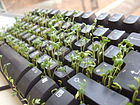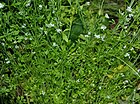Note: This is a project under development. The articles on this wiki are just being initiated and broadly incomplete. You can Help creating new pages.
Lepidium sativum - Charmahantri
Charmahantri is also known as Garden cress, mustard and cress, garden pepper cress, pepperwort pepper grass, chandrashura or poor man's pepper. Garden cress is genetically related to watercress and mustard, sharing their peppery, tangy flavor and aroma.
Uses
Parts Used
Chemical Composition
Atropine sulphate, carbachol (CCh), dicyclomine, isoprenaline, verapamil, and rolipram were purchased from Sigma Chemicals Company, St. Louis, MO, USA. Guinea-pigs (500–550 g) of either sex and local breed were kept at the Animal House of the Aga Khan University, maintained at 23–25°C, and were given standard diet and tap water[1]
Common names
| Language | Common name |
|---|---|
| Kannada | alavibija, alli beeja |
| Hindi | akalam, candsur |
| Malayalam | asali |
| Tamil | aali, aalividai |
| Telugu | aadithyalu, aandilee |
| Marathi | NA |
| Gujarathi | NA |
| Punjabi | NA |
| Kashmiri | NA |
| Sanskrit | ahaleeva, asalika |
| English | common cress, garden cress |
Properties
Reference: Dravya - Substance, Rasa - Taste, Guna - Qualities, Veerya - Potency, Vipaka - Post-digesion effect, Karma - Pharmacological activity, Prabhava - Therepeutics.
Dravya
Rasa
Katu (pungent)
Guna
Laghu (lightness), Rooksha (dryness), Teekshna (strong, piercing)
Veerya
Ushna (Hot potency)
Vipaka
Katu (pungent)
Karma
Kapha, Vata
Prabhava
whole plant – Laghu (lightness), Rooksha (dryness) Teekshna (strong, piercing) Seed – Snigdha – unctuous, oily, Picchila – Sticky Rasa (taste) – Katu (pungent) Vipaka- Katu – Undergoes pungent taste conversion after digestion Veerya- Ushna – Hot potency Effect on Tridosha – Balances Kapha and Vata Part used- Seeds Source: http://howwomenugh.ru/garden/25922-garden-cress-lepidium-sativum-uses-side-effects.html
Habit
Identification
Leaf
| Kind | Shape | Feature |
|---|---|---|
| Simple | The leaves are divided into 3-6 toothed leaflets, with smaller leaflets in between |
Flower
| Type | Size | Color and composition | Stamen | More information |
|---|---|---|---|---|
| Unisexual | 2-4cm long | Yellow | 5-20 | Flowers Season is June - August |
Fruit
| Type | Size | Mass | Appearance | Seeds | More information |
|---|---|---|---|---|---|
| 7–10 mm (0.28–0.4 in.) long pome | clearly grooved lengthwise, Lowest hooked hairs aligned towards crown | With hooked hairs | {{{6}}} |
Other features
List of Ayurvedic medicine in which the herb is used
- Vishatinduka Taila as root juice extract
Where to get the saplings
Mode of Propagation
How to plant/cultivate
Easily grown in most soils[21][22], preferring a calcareous soil. Thrives in a dry lightly shaded position[16], though it prefers full sun. Plants usually self-sow quite freely when growing in a suitable position[19]. The seeds are contained in burrs that can easily attach themselves to clothing or animal's fur, thus transporting them to a new area where they can germinate and grow.The cultivar 'Sweet scented' is popular in France for making tea because the whole plant is sweet scented and the flowers have a spicy apricot-like fragrance[3]
Commonly seen growing in areas
Photo Gallery
References
External Links
- Ayurvedic Herbs known to be helpful to treat Astama
- Ayurvedic Herbs known to be helpful to treat Cough
- Ayurvedic Herbs known to be helpful to treat Snakebites
- Ayurvedic Herbs known to be helpful to treat Counter gout
- Ayurvedic Herbs known to be helpful to treat Skin deseases
- Ayurvedic Herbs known to be helpful to treat Diabates
- Ayurvedic Herbs known to be helpful to treat Scurvy
- Ayurvedic Herbs known to be helpful to treat Diarrhea
- Ayurvedic Herbs known to be helpful to treat Blood pressure
- Herbs with Seeds used in medicine
- Herbs with Root used in medicine
- Herbs with Leaves used in medicine
- Herbs with common name in Kannada
- Herbs with common name in Hindi
- Herbs with common name in Malayalam
- Herbs with common name in Tamil
- Herbs with common name in Telugu
- Herbs with common name in Sanskrit
- Herbs with common name in English
- Habit - Annual plant
- Index of Plants which can be propagated by Seeds
- Index of Plants which can be propagated by Cuttings
- Herbs that are commonly seen in the region of Temperate area
- Herbs that are commonly seen in the region of At trophical area
- Herbs








